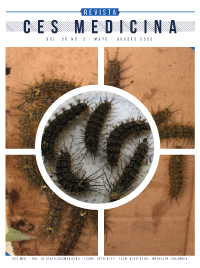Lonomic accident: Report of two cases
DOI:
https://doi.org/10.21615/cesmedicina.6714Keywords:
lonomia obliqua, lepidopterism, hemostasis, accident, venom, hemorrhageAbstract
Background: among the insects of the order Lepidoptera, the family Saturniidae has more than 2,400 species, there are Hylesia and Lonomia. Objective: to present two cases of patients with lonomic accident, the management and outcome to recognize the importance of these events in the wild regions of the Colombian orinoquia. Clinical case: an 8-year-old patient from a rural area who refers to contact in the palmar region of the right hand with worms for more than 48 hours, presents ecchymosis in the extremities, bleeding flictena in the right heel, headache, chills and arthralgias. Clotting times are performed which are prolonged. A 13-year-old patient who also referred contact without presenting clinical manifestations but presenting prolonged clotting times. They are considered to occur due to a lonomic accident, so 5 ampoules of polyvalent antilonomic serum are administered to each one without registering adverse reactions. They have an adequate clinical evolution with a decrease in the safe ranges of clotting times. Conclusions: the lonomic venom acts in the coagulation cascade producing hemorrhagic manifestations of variable severity. Antilonomic serum is the only effective treatment, despite being available for more than 20 years in Brazil, there is a 5% progression to severe hemorrhagic syndromes and 1.5 to 2% mortality. Despite being of great clinical relevance in the Americas, there is an underreporting, it is important to know its manifestations and management in order to avoid fatal complications.
Downloads
References
Miryam AF, Renata NG, Dilza TS, Douglas SO, Isabel CB, Marcus VB, et al. Lonomia obliqua Envenoming and Innovative Research. Toxins (Basel). 2021; 13 (12):832. Disponible en: https://doi.org/10.3390/toxins13120832
Spadacci-Morena DD, Soares MAM, Moraes RHP, Sano-Martins IS, Sciani JM. The urticating apparatus in the caterpillar of Lonomia obliqua (Lepidoptera: Saturniidae). Toxicon. 2016; 119:218–24. Disponible en: https://doi.org/10.1016/j.toxicon.2016.06.008
Seldeslachts A, Peigneur S, Tytgat J. Caterpillar venom: A health hazard of the 21st century. Biomedicines. 2020; 8(6):143. Disponible en: https://doi.org/10.3390/biomedicines8060143
Sano-Martins IS, Duarte AC, Guerrero B, Moraes RHP, Barros EJG, Arocha-Piñango CL. Hemostatic disorders induced by skin contact with Lonomia obliqua (Lepidoptera, Saturniidae) caterpillars. Rev Inst Med Trop Sao Paulo. 2017;59(0):e24. Disponible en: https://doi.org/10.1590/S1678-9946201759024
Delabranche, X.; Helms, J.; Meziani, F. Immunohaemostasis: A new view on haemostasis during sepsis. Ann. Intensive Care 2017(7): 117 – 125. Disponible en: https://doi.org/10.1186/s13613-017-0339-5
Santos JHA, Oliveira SS, Alves EC, Mendonça-da-Silva I, Sachett JAG, Tavares A, et al. Severe hemorrhagic syndrome after Lonomia caterpillar envenomation in the Western Brazilian Amazon: How many more cases are there? Wilderness Environ Med. 2017;28 (1):46–50. Disponible en: https://doi.org/10.1016/j.wem.2016.11.001
Medeiros DNM, Torres HCC, Troster EJ. Accident involving a 2-year-old child and Lonomia obliqua venom: clinical and coagulation abnormalities. Rev Bras Hematol Hemoter. 2014; 36(6):445–7. Disponible en: https://doi.org/10.1016/j.bjhh.2014.07.021
Haddad V Jr, Lastória JC. Envenomation by caterpillars (erucism): proposal for simple pain relief treatment. J Venom Anim Toxins Incl Trop Dis. 2014;20(1):21. Disponible en: https://doi.org/10.1186/1678-9199-20-21
Eric W Hossler, Ted Rosen, Abena O Ofori. Lepidopterism: Skin disorders secondary to caterpillars and moths. UpToDate. Disponible en https://www.uptodate.com/contents/lepidopterism-skin-disorders-secondary-to-caterpillars-and-moths
Sano-Martins IS, González C, Anjos IV, Díaz J, Gonçalves LRC. Effectiveness of Lonomia antivenom in recovery from the coagulopathy induced by Lonomia orientoandensis and Lonomia casanarensis caterpillars in rats. PLoS Negl Trop Dis. 2018;12(8):e0006721. Disponible en: https://doi.org/10.1371/journal.pntd.0006721
Berger M, Santi L, Beys-da-Silva WO, Oliveira FM, Caliari MV, Yates JR, et al. Mechanisms of acute kidney injury induced by experimental Lonomia obliqua envenomation. Arch Toxicol. 2015; 89:459–83. Disponible en: https://doi.org/10.1007/s00204-014-1264-0
Branco MMP, Borrasca-Fernandes CF, Prado CC, et al. Management of severe pain after dermal contact with caterpillars (erucism): a prospective case series. Clin Toxicol (Phila) 2019; 57:338. Disponible en: https://doi.org/10.1080/15563650.2018.1520998
Alvarez Flores, M.P.; Zannin, M.; Chudzinski-Tavassi, A.M. New Insight into the Mechanism of Lonomia obliqua envenoming: Toxin involvement and molecular approach. Pathophysiol. Haemost. Thromb. 2010, 37: 1–16. Disponible en: https://doi.org/10.1159/000320067
Berger M, Reck J Jr. Terra RM, Pinto AF, Termignoni C, Guimarães JA. Lonomia obliqua caterpillar envenomation causes platelet hypoaggregation and blood incoagulability in rats. Toxicon. 2010; 55(1):33–44. Disponible en: https://doi.org/10.1016/j.toxicon.2009.06.033
Ávila Albert Alejandro, Moreno Atilio, Garzón Andrés, Gómez Álvaro Andrés. Accidente lonómico. Acta Med Colomb [Internet]. 2013 38 (2): 95 - 100. Disponible en: http://www.scielo.org.co/scielo.php?script=sci_arttext&pid=S0120-24482013000200012&lng=en
Downloads
Published
How to Cite
Issue
Section
License
Copyright (c) 2022 CES Medicina

This work is licensed under a Creative Commons Attribution-NonCommercial-ShareAlike 4.0 International License.
Derechos de reproducción (copyright)
Cada manuscrito se acompañará de una declaración en la que se especifique que los materiales son inéditos, que no han sido publicados anteriormente en formato impreso o electrónico y que no se presentarán a ningún otro medio antes de conocer la decisión de la revista. En todo caso, cualquier publicación anterior, sea en forma impresa o electrónica, deberá darse a conocer a la redacción por escrito.
Plagios, duplicaciones totales o parciales, traduccones del original a otro idioma son de responsabilidad exclusiva de los autores el envío.
Los autores adjuntarán una declaración firmada indicando que, si el manuscrito se acepta para su publicación, los derechos de reproducción son propiedad exclusiva de la Revista CES Medicina.
Se solicita a los autores que proporcionen la información completa acerca de cualquier beca o subvención recibida de una entidad comercial u otro grupo con intereses privados, u otro organismo, para costear parcial o totalmente el trabajo en que se basa el artículo.
Los autores tienen la responsabilidad de obtener los permisos necesarios para reproducir cualquier material protegido por derechos de reproducción. El manuscrito se acompañará de la carta original que otorgue ese permiso y en ella debe especificarse con exactitud el número del cuadro o figura o el texto exacto que se citará y cómo se usará, así como la referencia bibliográfica completa.
| Article metrics | |
|---|---|
| Abstract views | |
| Galley vies | |
| PDF Views | |
| HTML views | |
| Other views | |



